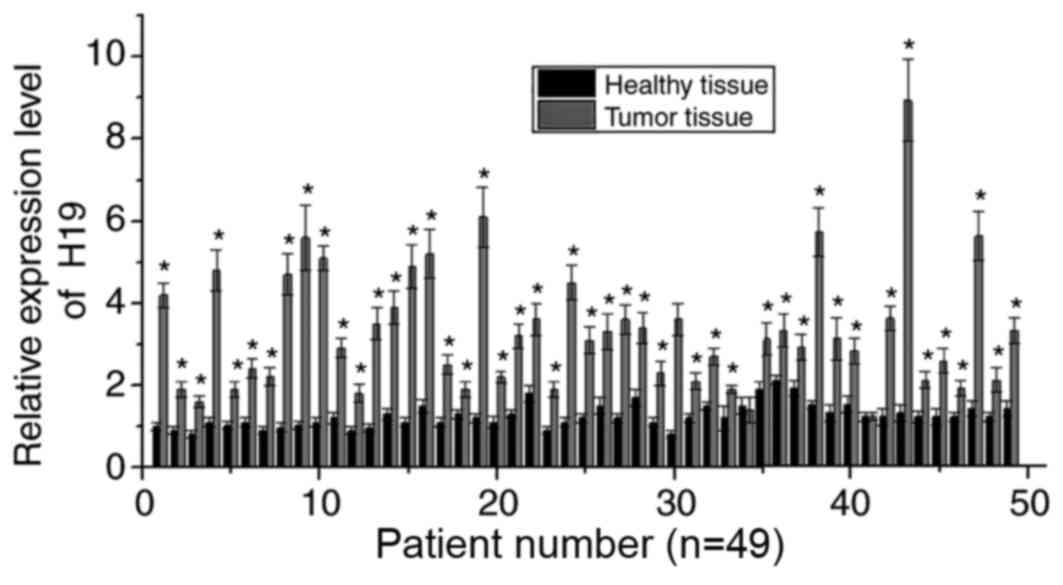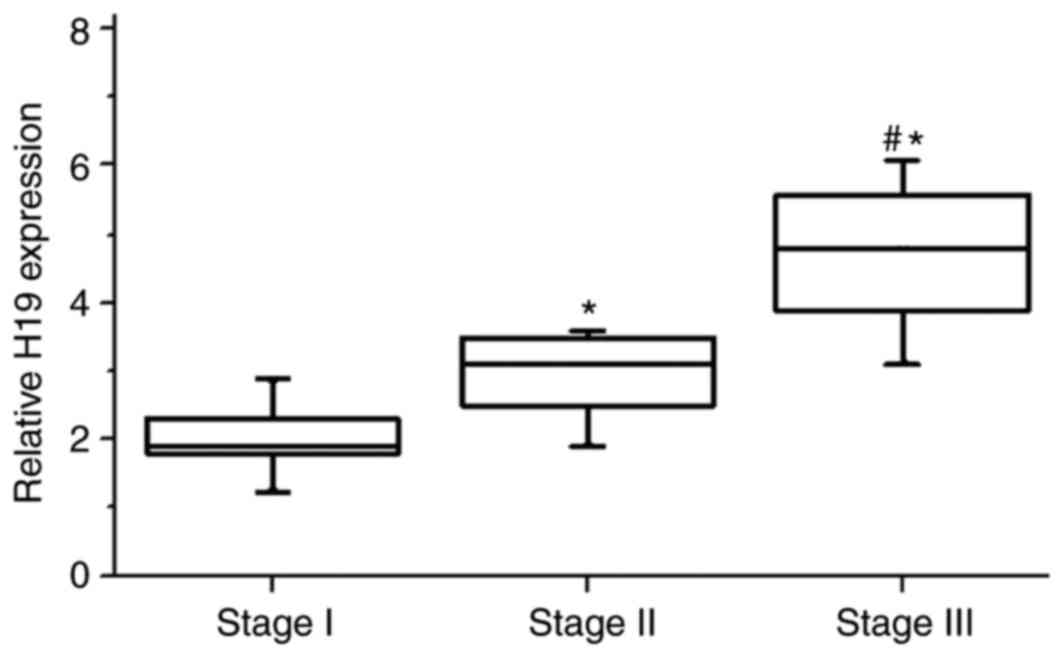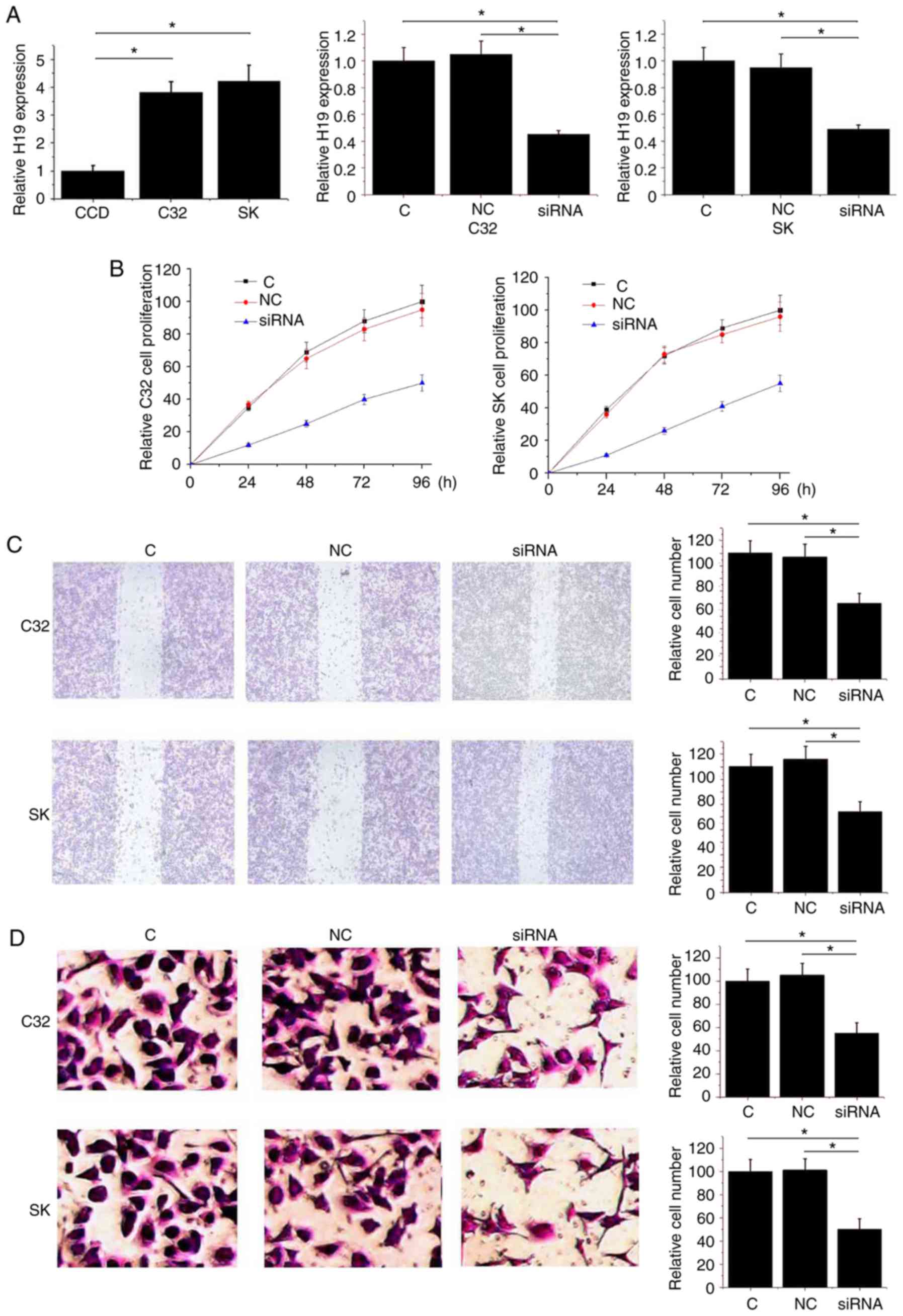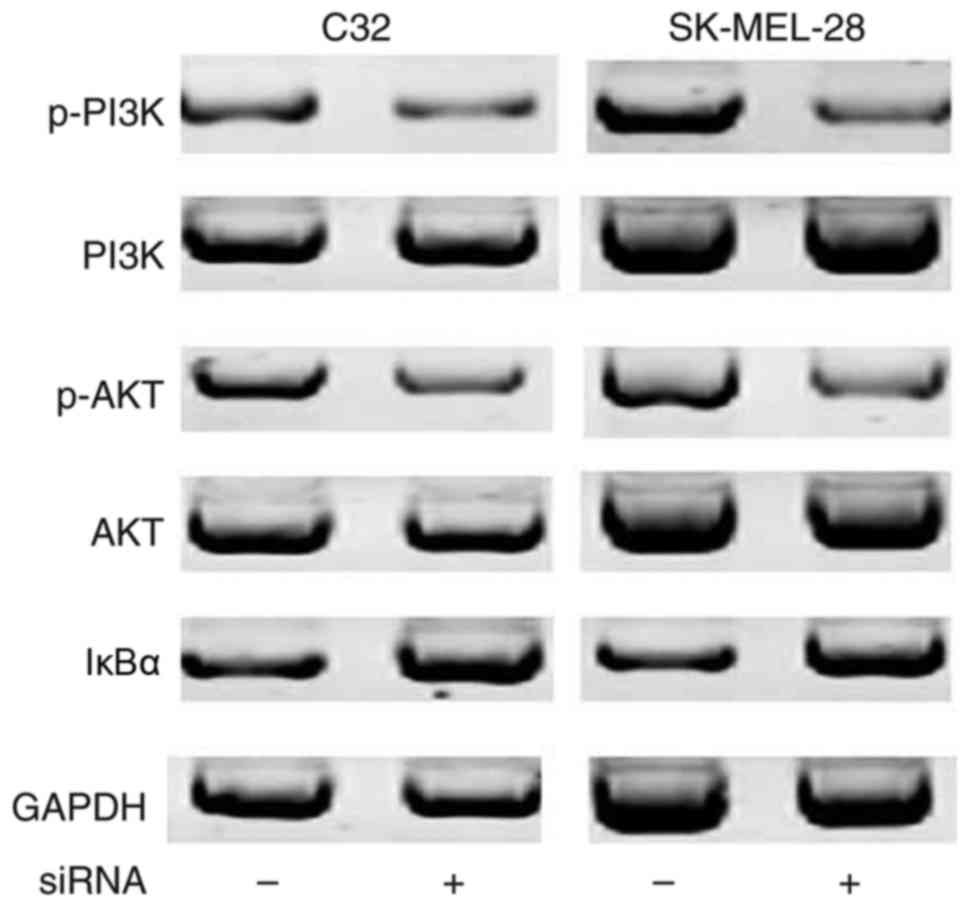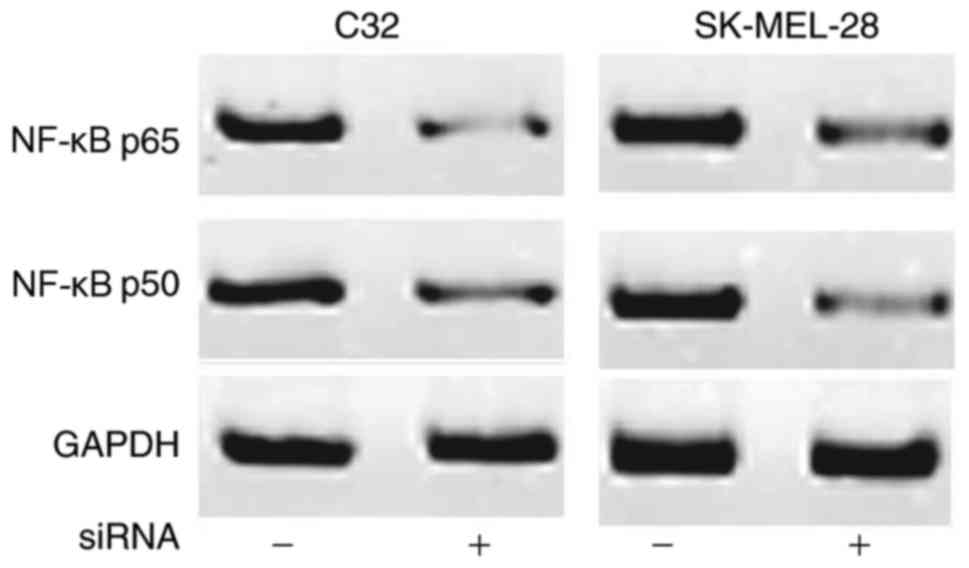Downregulation of lncRNA H19 inhibits the migration and invasion of melanoma cells by inactivating the NF‑κB and PI3K/Akt signaling pathways
- Authors:
- Published online on: March 20, 2018 https://doi.org/10.3892/mmr.2018.8782
- Pages: 7313-7318
Abstract
Introduction
Melanoma is a type of cancer that originates from cells containing pigment (1). Although melanoma is less common compared with squamous cell carcinomas and cutaneous basal cell carcinomas, melanoma is considered to be one of the most common causes of cancer-associated mortalities in young adults and children (2). The highest incidence of melanoma has been observed in Australia and New Zealand, followed by North America and Northern Europe, while the incidence of this disease is relatively low in Latin America, Africa and Asia (3). In addition, melanoma was also revealed to be more common in men than in women (4). With proper treatment, the 5-year survival rate of patients only with local tumors may reach 98%. However, once metastasis has occurred, the 5-year survival rate may be as low as 17% (5). Similar to other tumors, the development and progression of melanoma is a complex process with multiple signaling pathways involved (6,7). Therefore, an in-depth analysis of the signal transduction regulation involved in melanoma will facilitate the development of novel treatment strategies for this disease.
Long non-coding RNA (lncRNA), is a group of noncoding RNAs with a length >200 nucleotides (8). A previous study has demonstrated that the onset and development of different human cancers requires the involvement of various lncRNAs (9). As a lncRNA, H19 has been demonstrated to serve a role as an oncogene in various human malignant tumors (10,11). However, based on current knowledge, the functionality of H19 in melanoma remains unclear.
In the present study, the expression of H19 in the tumor tissues and adjacent healthy tissues of 59 patients with melanoma was detected. The effects of H19 on proliferation, migration and invasion of two melanoma cells lines were investigated. In addition, the interactions between H19 and the nuclear factor (NF)-κB signaling pathway were also explored. The results of the present study may benefit future studies on the pathogenesis of melanoma and the clinical treatment of this disease.
Materials and methods
Patients
A total of 49 patients with melanoma were recruited to the present study in the Tianjin Medical University Cancer Institute and Hospital (Tianjin, China) from October 2013 to August 2017. Patients diagnosed with other severe diseases and mental health problems were excluded. Patients were diagnosed via imaging examinations and pathological tests. The patients were then divided into 3 tumor stage groups according to tumor thickness. These groups were characterized by the following diagnostic criteria: Stage I, tumor thickness <1.0 mm; stage II, tumor thickness between 1.0 and 4.0 mm; and stage III, tumor thickness >4.0 mm. Patients in stage I included 7 males and 8 females, with an age range of 21 to 68 years and an average age of 43±11.6 years; patients in stage II included 8 males and 9 females, with an age range of 27 to 72 years and an average age of 48±13.1 years; patients in stage III included 8 males and 7 females, with an age range of 24 to 73 years and an average age of 46±11.0 years. No significant differences in age, sex and other basic information were found among different stages. All patients received surgical resection, and tumor tissues and surrounding healthy tissue (within 1 cm around tumor) were collected during the operation. The present study was approved by the Ethics Committee of Tianjin Medical University Cancer Institute and Hospital, and all patients provided written informed consent.
Cell lines and cell culture
Human melanoma cell lines C32 and SK-MEL-28, and the normal skin cell line CCD-1059Sk were all purchased from American Type Culture Collection (Manassas, VA, USA). Cell culture was performed according to manufacturer's protocol in Eagle's minimum Essential medium (EMEM; American Type Culture Collection) containing 10% fetal bovine serum (FBS, Sigma-Aldrich; Merck KGaA, Darmstadt, Germany). Cells were harvested during the logarithmic growth phase for subsequent experiments.
Reverse transcription-quantitative polymerase chain reaction (RT-qPCR)
Total RNA was extracted from tumor tissues, adjacent healthy tissues and cells using TRIzol reagent (Invitrogen; Thermo Fisher Scientific, Inc., Waltham, MA, USA). Tissues were ground in liquid nitrogen before the addition of TRIzol reagent. RNA quality was determined using a NanoDrop™ 2000 Spectrophotometer (Thermo Fisher Scientific, Inc.), and only RNA samples with a A260/A280 ratio between 1.8 and 2.0 were used to synthesize cDNA via reverse transcription using SuperScript III Reverse Transcriptase (Thermo Fisher Scientific, Inc.). Reaction conditions for reverse transcription were: 65°C for 5 min, 50°C for 50 min and 85°C for 5 min. A qPCR reaction system was prepared using cDNA and SYBR®-Green Real-Time PCR Master mix (Thermo Fisher Scientific, Inc.). Following primers were used in the PCR reactions: 5′-TGAGCTCTCAGGAGGGAGGATGG-3′ (forward) and 5′-TTGTCACGTCCACCGGACCTG-3′ (reverse) for H19; 5′-GACCTCTATGCCAACACAGT-3′ (forward) and 5′-AGTACTTGCGCTCAGGAGGA-3′ (reverse) for β-actin. The qPCR thermocycling conditions were as follows: 95°C for 42 sec, followed by 40 cycles of 95°C for 10 sec and 60°C for 35 sec. Data were analyzed using the 2−ΔΔCq method (12), and the relative expression levels of H19 were normalized to those of the endogenous control β-actin.
Establishment of H19 small interfering (si)RNA silencing cell lines
H19 siRNA silencing cell lines were constructed using commercial siRNAs. Silencer™ Select Negative Control No. 1 siRNA (cat. no. 4390843; Thermo Fisher Scientific, Inc.) and H19 siRNA (cat. no. 1299001; Thermo Fisher Scientific, Inc.) were used. Prior to transfection, cells were cultured EMEM containing 10% FBS overnight to reach 80–90% confluence. Lipofectamine 2000™ reagent (cat. no. 11668-019; Invitrogen, Thermo Fisher Scientific, Inc.) was used to transfect 40 nM siRNA into 5×105 cells by incubation with the cells at 37°C in a CO2 incubator for 4 h according to the manufacturer's protocol, followed by incubation in RPMI-1640 medium (Hyclone; GE Healthcare Life Sciences, Logan, UT, USA) at 37°C for 48 h prior to subsequent experimentation.
Cell proliferation assay
Cell proliferation ability was measured using a Cell Counting kit-8 (CCK-8; Sigma-Aldrich; Merck KGaA) according to the manufacturer's protocol. Briefly, 100 µl cell suspension containing 2×104 cells was transferred to each well of a 96-well plate. CCK-8 solution (10 µl) was added into each well for cell culture for 24, 48, 72 and 96 h. Following incubation at 37°C for a further 4 h, the optical density values were measured at a wavelength of 450 nm using a microplate reader (Bio-Rad Laboratories, Inc., Hercules, CA, USA).
Wound-healing assay
Cells were seeded into a 24-well plate at 1×105 cells per well. Once cell adhesion was reached (following 48 h), a pipette tip was used to scratch the cells. Cells were washed with PBS and cultured in an incubator (37°C, 5% CO2) for 24 h to reach ~70–80% confluence. Cell migration was observed under an inverted microscope (Olympus Corporation, Tokyo, Japan), 10 fields of view were randomly selected and images were obtained. ImagePro Plus version 5.0 software (National Institutes of Health, Bethesda, MD, USA) was used to analyze all images.
Cell invasion assay
Transwell cell invasion assay (BD Biosciences, Franklin Lakes, NJ, USA) was performed to measure the cell invasion ability. The upper chamber was pre-coated with Matrigel (cat. no. 356234; EMD Millipore, Billerica, MA, USA) and filled with serum-free RPMI-1640 medium (Thermo Fisher Scientific, Inc.) containing 5×104 cells. RPMI-1640 medium containing 20% fetal calf serum (Sigma-Aldrich, Merck KGaA) was used to fill the lower chamber. Following incubation at 37°C for 24 h, membranes were collected and stained with 0.5% crystal violet (Sigma-Aldrich; Merck KGaA) at room temperature for 20 min. A total of 10 fields of vision were randomly selected and stained cells were counted under an optical microscope (Olympus Corporation).
Western blotting
Following protein extraction using radioimmunoprecipitation assay buffer (Thermo Fisher Scientific, Inc.), the concentration of protein samples was measured using a Bicinchoninic Acid assay. Then, 10% SDS-PAGE gel electrophoresis was performed using 30 µg of protein from each sample, followed by transfer to a polyvinylidene difluoride membrane under 25 V for 1 h. Blocking was performed using 5% skimmed milk at room temperature for 1 h. Following washing with TBST (0.1% Tween-20), membranes were then incubated with the corresponding primary antibodies including rabbit anti-phosphorylated (p)-phosphoinositide 3-kinase (PI3K) antibody (1:2,000; cat. no. ab182651; Abcam, Cambridge, UK), anti-PI3K antibody (1:2,000; cat. no. ab5451; Abcam), anti-p-protein kinase B (AKT) antibody (1:2,000; cat. no. ab18206; Abcam), anti-AKT antibody (1:2,000; cat. no. ab126811; Abcam), anti-inhibitor of nuclear factor κβ (IκBα) antibody (1:1,000; cat. no. ab76429; Abcam), anti-NF-κB p65 antibody (1:1,000; cat. no. ab16502; Abcam), anti-NF-κB p50 antibody (1:1,000; cat. no. ab32360; Abcam) and anti-β-actin primary antibody (1:1,000; cat. no. ab8226; Abcam) overnight at 4°C. Following washing with PBS, membranes were further incubated with anti-rabbit IgG-horseradish peroxidase secondary antibody (1:1,000; cat. no. MBS435036; MyBioSource, San Diego, CA, USA) at room temperature for 1 h. Membranes were then washed with TBST and signals were detected using an enhanced chemiluminescence substrate (Sigma-Aldrich; Merck KGaA) method. Relative expression levels of each protein were normalized to the endogenous control, β-actin, using ImageJ 1.8.0 software (National Institutes of Health).
Statistical analysis
SPSS software version 19.0 (IBM Corp., Armonk, NY, USA) was used for all statistical analyses. Each experiment was performed three times, and results are presented as the mean ± standard deviation. Data between two groups were analyzed by Student's t-test and multiple comparisons were analyzed by one way analysis of variance with a least significant difference post hoc test. P<0.05 was considered to indicate a statistically significant difference.
Results
H19 is upregulated in melanoma tumor tissue compared with adjacent healthy tissue
RT-qPCR was performed to detect the mRNA expression of H19 in the tumor and adjacent healthy tissues of 49 patients with melanoma. As shown in Fig. 1, compared with adjacent healthy tissues, the mRNA expression levels of H19 were significantly increased in the cancerous tissues of 47 of 49 patients (P<0.05), suggesting the potential involvement of H19 in the development of melanoma.
Expression of H19 increases with the development of melanoma
Patients were divided into different stages according to their tumor thickness. As shown in Fig. 2, the expression levels of H19 RNA in tumor tissues were significantly higher in patients with stage II than in patients with stage I (P<0.05). Similarly, the expression levels of H19 RNA in tumor tissues were also significantly higher in patients with stage III compared with patients with stage II (P<0.05). These results suggested that the expression of H19 was greater with increasing stages of melanoma.
H19 knockdown inhibits the proliferation, migration and invasion of melanoma cells
As shown in Fig. 3A, compared with the normal skin cell line CCD-1059Sk, expression levels of H19 RNA were significantly increased in the human melanoma cell line C32 and SK-MEL-28 (P<0.05). Following siRNA transfection, the expression levels of H19 RNA were significantly reduced in the C32 and SK-MEL-28 cell lines (P<0.05; Fig. 3A). As shown in Fig. 3B, downregulation of H19 significantly reduced the proliferation ability of C32 and SK-MEL-28 cells (P<0.05). Similarly, downregulation of H19 also significantly reduced the migration and invasion ability of C32 and SK-MEL-28 (P<0.05; Fig. 3C and D). The data suggested that H19 knockdown inhibited the proliferation, migration and invasion of melanoma cells.
H19 siRNA silencing inhibits the activation of the NF-κB signaling pathway
It has been well established that the NF-κB signaling pathway may be activated by the PI3K/Akt signaling pathway via the degradation of IκBα. As shown in Fig. 4, no differences in the expression levels of PI3K and Akt were observed between control cells and cells transfected with siRNA. Compared with cells without siRNA transfection, the expression levels of p-PI3K and p-Akt were decreased in cells transfected with siRNA, indicating inactivation of the PI3K/Akt signaling pathway following H19 knockdown. In addition, compared with cells without siRNA transfection, expression levels of the IκBα protein were increased in cells with siRNA transfection, indicating reduced degradation of IκBα following H19 knockdown. These data suggested that H19 knockdown inactivated the PI3K/Akt signaling pathway, which in turn inhibited the activation of the NF-κB signaling pathway.
H19 inhibits the expression of NF-κB p65 and p50
The expression of NF-κB p65 and p50 may be regulated by certain lncRNAs. Therefore, the effect of H19 knockdown on the expression levels of NF-κB p65 and p50 were investigated. As shown in Fig. 5, compared with the cells without siRNA transfection, expression levels of NF-κB p65 and p50 were decreased in cells following siRNA transfection. These data suggested that H19 knockdown inhibited the NF-κB signaling pathway by downregulating the expression levels of NF-κB p65 and p50.
Discussion
Previous studies have demonstrated that the development of melanoma is accompanied by alterations in the expression levels of various lncRNAs (13–15). The expression levels of lncRNA urothelial cancer associated 1 and metastasis associated lung adenocarcinoma transcript 1 have been reported to be significantly increased along with the development of melanoma, and the expression of these two lncRNAs were significantly associated with the treatment outcomes and prognosis of this disease (14). By contrast, lncRNA growth arrest specific 5 (GAS5) may serve a role as an anticancer factor in melanoma by regulating gelatinase A and B, and the overexpression of lncRNA GAS5 significantly inhibited the development of this disease (16). As an oncogene, H19 was upregulated in patients with different types of cancers (17–19). However, the expression pattern of H19 in patients with melanoma remains unknown. In the present study, the expression levels of H19 were observed to be significantly higher in tumor tissues than in the adjacent healthy tissues of 47 out of 49 patients with melanoma. In addition, the expression of H19 was also revealed to be significantly increased along with the stage development of melanoma. These data suggested that H19 may be involved in the development of melanoma.
Numerous studies have shown that lncRNA H19 participates in different human cancers primarily by promoting tumor metastasis. In a study of gastric cancer, Zhou et al (20) reported that H19 negatively regulated the expression of microRNA (miR)-141, which in turn promoted the proliferation and invasion of cancer cells. In another study, H19 was demonstrated to serve pivotal roles in regulating the invasion of glioma cells, and this function of H19 was associated with miR-675 derived from H19 (21). A previous study on cholangiocarcinoma reported that the expression levels of H19 were upregulated by oxidative stress, and the increased expression level of H19 promoted the migration and invasion of tumor cells by targeting interleukin-6 and C-X-C chemokine receptor type 4 (22). In the present study, the effects of H19 on the development of melanoma was investigated using H19 knockdown via siRNA transfection. Proliferation, invasion and migration abilities of melanoma cells were revealed to be significantly reduced following siRNA transfection. These data suggested that H19 served a role as an oncogene in the development of melanoma, and the downregulation of H19 may inhibit the progression of tumors by reducing the invasion of migration abilities of tumor cells.
As a key factor in cancerogenesis, the NF-κB signaling pathway has important functions in almost every step of the initiation, development and progression of tumorigenesis (23). It has been reported that the NF-κB signaling pathway interacts with H19 to perform its biological functions (24). It is also well known that IκBα degradation mediated by the activation of the PI3K/Akt signaling pathway may lead to the activation of the NF-κB signaling pathway (25,26). In the present study, no obvioust differences in the expression levels of PI3K and Akt were identified between melanoma cells with and without H19 knockdown. However, phosphorylation levels of PI3K and Akt were decreased, and the expression levels of IκBα were increased in melanoma cells with H19 knockdown than in cells without H19 knockdown. These data suggested that H19 knockdown may inactivate the PI3K/Akt signaling pathway, which in turn may lead to the inactivation of the NF-κB signaling pathway.
In conclusion, H19 was upregulated in melanoma tumor tissue. Downregulation of H19 inhibited the proliferation, migration and invasion of melanoma cells, and the function of H19 in melanoma may be achieved by the inhibition of the NF-κB signaling pathway via the inactivation of the PI3K/Akt signaling pathway. However, the present study may be limited by the small sample size. Thus, further studies with larger sample sizes are required to further confirm these conclusions.
References
|
Hodis E, Watson IR, Kryukov GV, Arold ST, Imielinski M, Theurillat JP, Nickerson E, Auclair D, Li L, Place C, et al: A landscape of driver mutations in melanoma. Cell. 150:251–263. 2012. View Article : Google Scholar : PubMed/NCBI | |
|
Allen DC: Malignant melanomaHistopathology Reporting. Springer; London: pp. 207–216. 2013, View Article : Google Scholar | |
|
Stewart BW and Wild CP: World Cancer Report 2014. IARC Publications; Lyon: 2017 | |
|
Azoury SC and Lange JR: Epidemiology, risk factors, prevention, and early detection of melanoma. Surg Clin North Am. 94(945–62): vii2014. View Article : Google Scholar | |
|
Topalian SL, Sznol M, McDermott DF, Kluger HM, Carvajal RD, Sharfman WH, Brahmer JR, Lawrence DP, Atkins MB, Powderly JD, et al: Survival, durable tumor remission, and long-term safety in patients with advanced melanoma receiving nivolumab. J Clin Oncol. 32:1020–1030. 2014. View Article : Google Scholar : PubMed/NCBI | |
|
Atefi M, Avramis E, Lassen A, Wong DJ, Robert L, Foulad D, Cerniglia M, Titz B, Chodon T, Graeber TG, et al: Effects of MAPK and PI3K pathways on PD-L1 expression in melanoma. Clin Cancer Res. 20:3446–3457. 2014. View Article : Google Scholar : PubMed/NCBI | |
|
Pal HC, Sharma S, Strickland LR, Katiyar SK, Ballestas ME, Athar M, Elmets CA and Afaq F: Fisetin inhibits human melanoma cell invasion through promotion of mesenchymal to epithelial transition and by targeting MAPK and NFκB signaling pathways. PLoS One. 9:e863382014. View Article : Google Scholar : PubMed/NCBI | |
|
Perkel JM: Visiting ‘noncodarnia’. Biotechniques. 54(301): 303–304. 2013. | |
|
Ning S, Zhang J, Wang P, Zhi H, Wang J, Liu Y, Gao Y, Guo M, Yue M, Wang L and Li X: Lnc2Cancer: A manually curated database of experimentally supported lncRNAs associated with various human cancers. Nucleic Acids Res. 44:D980–D985. 2016. View Article : Google Scholar : PubMed/NCBI | |
|
Yang F, Bi J, Xue X, Zheng L, Zhi K, Hua J and Fang G: Up-regulated long non-coding RNA H19 contributes to proliferation of gastric cancer cells. FEBS J. 279:3159–3165. 2012. View Article : Google Scholar : PubMed/NCBI | |
|
Luo M, Li Z, Wang W, Zeng Y, Liu Z and Qiu J: Long non-coding RNA H19 increases bladder cancer metastasis by associating with EZH2 and inhibiting E-cadherin expression. Cancer Lett. 333:213–221. 2013. View Article : Google Scholar : PubMed/NCBI | |
|
Livak KJ and Schmittgen TD: Analysis of relative gene expression data using real-time quantitative PCR and the 2(-Delta Delta C(T)) method. Methods. 25:402–408. 2001. View Article : Google Scholar : PubMed/NCBI | |
|
Khaitan D, Dinger ME, Mazar J, Crawford J, Smith MA, Mattick JS and Perera RJ: The melanoma-upregulated long noncoding RNA SPRY4-IT1 modulates apoptosis and invasion. Cancer Res. 71:3852–3862. 2011. View Article : Google Scholar : PubMed/NCBI | |
|
Tian Y, Zhang X, Hao Y, Fang Z and He Y: Potential roles of abnormally expressed long noncoding RNA UCA1 and Malat-1 in metastasis of melanoma. Melanoma Res. 24:335–341. 2014. View Article : Google Scholar : PubMed/NCBI | |
|
Tang L, Zhang W, Su B and Yu B: Long noncoding RNA HOTAIR is associated with motility, invasion, and metastatic potential of metastatic melanoma. Biomed Res Int. 2013:2510982013. View Article : Google Scholar : PubMed/NCBI | |
|
Chen L, Yang H, Xiao Y, Tang X, Li Y, Han Q, Fu J, Yang Y and Zhu Y: LncRNA GAS5 is a critical regulator of metastasis phenotype of melanoma cells and inhibits tumor growth in vivo. Onco Targets Ther. 9:4075–4087. 2016. View Article : Google Scholar : PubMed/NCBI | |
|
Li H, Yu B, Li J, Su L, Yan M, Zhu Z and Liu B: Overexpression of lncRNA H19 enhances carcinogenesis and metastasis of gastric cancer. Oncotarget. 5:2318–2329. 2014. View Article : Google Scholar : PubMed/NCBI | |
|
Liang WC, Fu WM, Wong CW, Wang Y, Wang WM, Hu GX, Zhang L, Xiao LJ, Wan DC, Zhang JF and Waye MM: The lncRNA H19 promotes epithelial to mesenchymal transition by functioning as miRNA sponges in colorectal cancer. Oncotarget. 6:22513–22525. 2015. View Article : Google Scholar : PubMed/NCBI | |
|
Zhu M, Chen Q, Liu X, Sun Q, Zhao X, Deng R, Wang Y, Huang J, Xu M, Yan J and Yu J: lncRNA H19/miR-675 axis represses prostate cancer metastasis by targeting TGFBI. FEBS J. 281:3766–3775. 2014. View Article : Google Scholar : PubMed/NCBI | |
|
Zhou X, Ye F, Yin C, Zhuang Y, Yue G and Zhang G: The interaction between MiR-141 and lncRNA-H19 in regulating cell proliferation and migration in gastric cancer. Cell Physiol Biochem. 36:1440–1452. 2015. View Article : Google Scholar : PubMed/NCBI | |
|
Shi Y, Wang Y, Luan W, Wang P, Tao T, Zhang J, Qian J, Liu N and You Y: Long non-coding RNA H19 promotes glioma cell invasion by deriving miR-675. PLoS One. 9:e862952014. View Article : Google Scholar : PubMed/NCBI | |
|
Wang WT, Ye H, Wei PP, Han BW, He B, Chen ZH and Chen YQ: LncRNAs H19 and HULC, activated by oxidative stress, promote cell migration and invasion in cholangiocarcinoma through a ceRNA manner. J Hematol Oncol. 9:1172016. View Article : Google Scholar : PubMed/NCBI | |
|
Hoesel B and Schmid JA: The complexity of NF-κB signaling in inflammation and cancer. Mol Cancer. 12:862013. View Article : Google Scholar : PubMed/NCBI | |
|
Pan JX: LncRNA H19 promotes atherosclerosis by regulating MAPK and NF-kB signaling pathway. Eur Rev Med Pharmacol Sci. 21:322–328. 2017.PubMed/NCBI | |
|
Hyam SR, Lee IA, Gu W, Kim KA, Jeong JJ, Jang SE, Han MJ and Kim DH: Arctigenin ameliorates inflammation in vitro and in vivo by inhibiting the PI3K/AKT pathway and polarizing M1 macrophages to M2-like macrophages. Eur J Pharmacol. 708:21–29. 2013. View Article : Google Scholar : PubMed/NCBI | |
|
Han W, Xiong Y, Li Y, Fang W, Ma Y, Liu L, Li F and Zhu X: Anti-arthritic effects of clematichinenoside (AR-6) on PI3K/Akt signaling pathway and TNF-α associated with collagen-induced arthritis. Pharm Biol. 51:13–22. 2013. View Article : Google Scholar : PubMed/NCBI |



